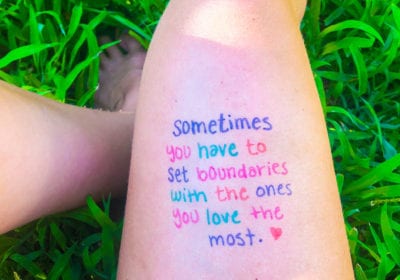
For me, anxiety physically manifests itself by constricting my throat and weighing down my chest. Jumbled thoughts heave themselves at me with urgent chaos that demands attention. Feelings of fear flood my body shouting, “DANGER!”
When in all reality I am perfectly safe, although slightly uncomfortable, trying to figure out what to eat for lunch in a sea of options in my office cafeteria.
Not all people feel anxiety in the same way – some have sweaty palms while others may take quick shallow breaths and feel tightness across their chest. Anxiety triggers range from health concerns to social acceptance to decision making, you name it.
Regardless of how we experience anxiety, our physical “fight or flight” response is wide awake and scrambling for a solution. Our body then sends messages to our conscious mind signaling that there is something seriously wrong. These signals are telling us we need to pay attention now and take action quickly to keep ourselves safe.
Anxiety may feel like a monster, but in all reality, it’s
purpose is to help protect us. But anxiety is not the best leader, and if given to much power it can quickly label everything as DANGER!
Have you ever seen the Pixar movie “Inside Out”? It is a thoughtful story teaching kids about their feelings. The film depicts emotions as separate characters in the brain control room on a little girl named Riley. When Joy has control, life is full of wonder and laughter with the occasional input from Sadness, Anger, Disgust or Fear. When Sadness has control, Riley perceives a much different world although her experiences did not significantly shift.
Emotions serve to help us process the world around us and at their core they are here to help us survive. Kate Allan, known on Instagram as @thelatestkate, is an artist who makes complicated feelings simple and relatable while teaching about mental health. On Kate’s post about handling negative thoughts, she writes, “Fact: Every emotion you experience has a specific purpose. Fear: Prompts us to flee from danger. Embarrassment: Demonstrates self-awareness to others.”
In both the case of the movie “Inside Out” and in Kate Allan’s post on negative thoughts, Fear is the closest emotion to what we know as Anxiety. The physical responses of fear and anxiety are very similar. The main difference arises in what causes each emotion.
The Difference between Anxiety and Fear
Fear presents itself when we are confronted with a real threat. For example, if you were laying in bed and somebody kicked in your front door,
Anxiety presents itself when there is uncertainty or perceived danger (including unwanted thoughts). For example, if you were laying in bed alone getting startled by every unexpected noise with a racing heart, you would most likely be experiencing anxiety.
The logical decision maker of the brain known as the frontal cortex receives information from many other parts of the brain. Emotions like fear and anxiety are born in the amygdala. The amygdala then simultaneously send messages all over the brain and to the frontal cortex.
The voice of the amygdala sounds something like, “Did you hear that noise? This is not safe. Is somebody breaking in? Go hide in your bathroom!” The voice of the frontal cortex sounds something like, “I got your messages of danger. I checked out the situation, and it’s just the cat jumping down from the counter. You are safe, resume what you were doing.”
Robert Sapolsky, an insightful neuroscientist, writes about fear and the amygdala in his book Behave, “When we stop fearing something, it isn’t because some amygdaloid neurons have lost their excitability. We don’t passively forget that something is scary. We actively learn that it isn’t scary anymore.” A few pages later he writes, “The hippocampus [in charge of memory] decides whether a factoid is worth filing away, depending on whether the amygdala has gotten worked up over it.”
By now you may be thinking – Great! I know anxiety felt like fear. I know neither should be in the control seat of my brain BUT how do I keep these urgent demands from controlling my behavior.
There are many approaches to help work through these emotions. Two I will suggest to you here are Cognitive Behavioral Therapy (CBT) and practicing Mindfulness.
Cognitive Behavioral Therapy is a form of psychotherapy that identifies unhelpful thoughts and helps develop strategies to challenge those thoughts. CBT is effective in treating a broad range of anxiety disorders by reshaping how we perceive harmful thoughts and emotions.
Mindfulness is the practice of becoming aware of one’s thoughts, feelings, and the surrounding environment in a non-judgemental way. Changing our perspective allows us to recognize how our behavior is affected by inputs we were previously unconscious of. I often refer to being mindful as “watching the basketball game” versus “playing in the basketball game.” Thoughts and feelings will arise on their own. When I am watching versus playing, it allows me to make a more informed decision on how to react.
Fear and anxiety elicit eerily similar physical responses in the body. A perceived danger works hard to appear as a real danger. Using techniques like CBT and mindfulness can increase our emotional intelligence. These techniques also allow for the opportunity to make more informed decisions on how to react to very demanding emotions.



